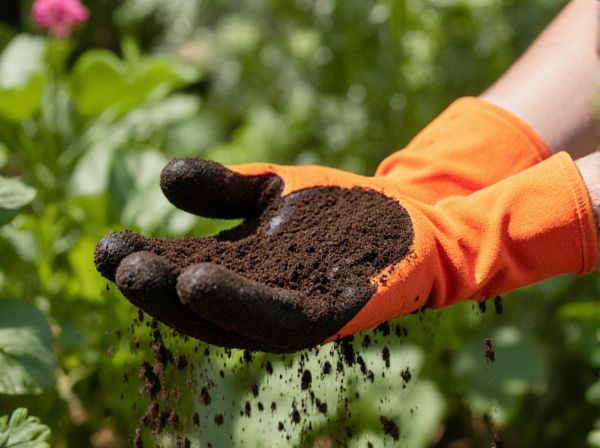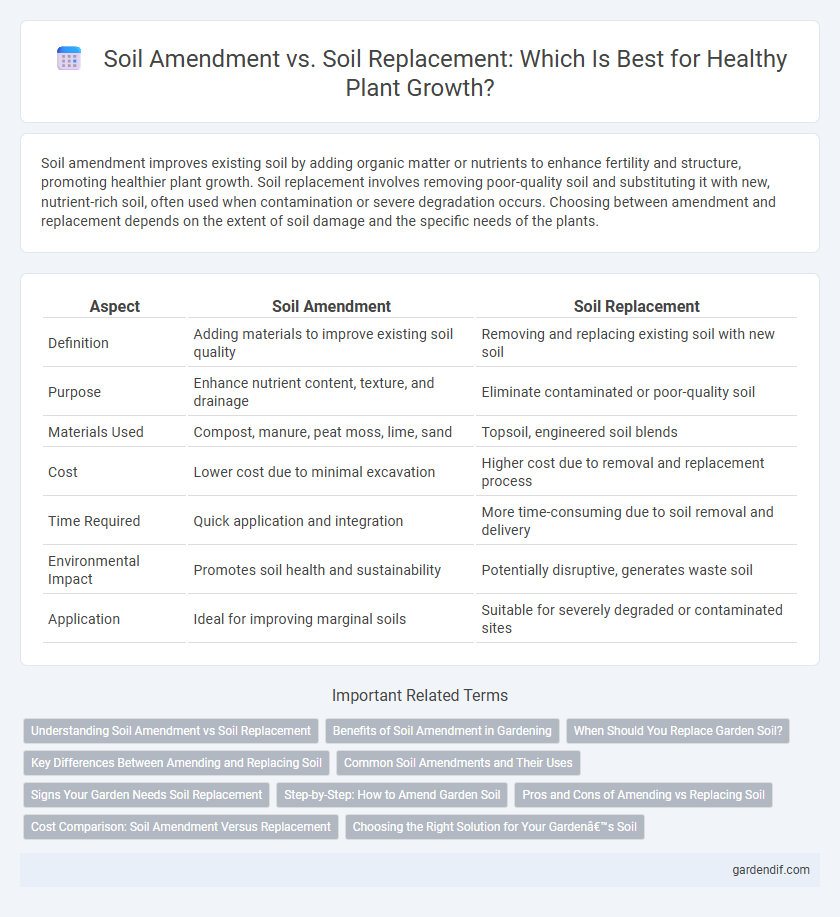
Soil amendment vs Soil replacement Illustration
Soil amendment improves existing soil by adding organic matter or nutrients to enhance fertility and structure, promoting healthier plant growth. Soil replacement involves removing poor-quality soil and substituting it with new, nutrient-rich soil, often used when contamination or severe degradation occurs. Choosing between amendment and replacement depends on the extent of soil damage and the specific needs of the plants.
Table of Comparison
| Aspect | Soil Amendment | Soil Replacement |
|---|---|---|
| Definition | Adding materials to improve existing soil quality | Removing and replacing existing soil with new soil |
| Purpose | Enhance nutrient content, texture, and drainage | Eliminate contaminated or poor-quality soil |
| Materials Used | Compost, manure, peat moss, lime, sand | Topsoil, engineered soil blends |
| Cost | Lower cost due to minimal excavation | Higher cost due to removal and replacement process |
| Time Required | Quick application and integration | More time-consuming due to soil removal and delivery |
| Environmental Impact | Promotes soil health and sustainability | Potentially disruptive, generates waste soil |
| Application | Ideal for improving marginal soils | Suitable for severely degraded or contaminated sites |
Understanding Soil Amendment vs Soil Replacement
Soil amendment improves existing soil quality by adding organic matter, nutrients, or conditioners to enhance structure, fertility, and water retention, making it ideal for minor soil issues. Soil replacement involves removing and substituting the poor-quality soil with new topsoil or substrate, necessary when contamination, severe compaction, or salinity drastically impair plant growth. Understanding the differences guides optimal horticultural practices, balancing cost, labor, and long-term soil health for sustainable plant development.
Benefits of Soil Amendment in Gardening
Soil amendment enhances soil fertility by improving texture, aeration, and nutrient retention, promoting healthier plant growth. It supports sustainable gardening practices by minimizing the need for chemical fertilizers and reducing soil erosion. Unlike soil replacement, soil amendment preserves the existing soil ecosystem, maintaining beneficial microorganisms essential for plant health.
When Should You Replace Garden Soil?
Replace garden soil when contamination, excessive compaction, or persistent drainage problems significantly impair plant growth and soil health. Soil replacement is essential if soil tests reveal toxic chemicals, high salinity, or severe nutrient depletion that cannot be corrected through amendments. For general fertility issues or minor imbalances, soil amendments such as compost or organic matter improve structure and nutrient content without the need for full soil replacement.
Key Differences Between Amending and Replacing Soil
Soil amendment improves existing soil by adding organic matter, nutrients, and minerals to enhance fertility, structure, and water retention, while soil replacement involves completely removing and substituting soil with new, typically engineered, soil. Amending is cost-effective for enhancing soil quality in situ with minimal disturbance, whereas replacement is necessary when soil is contaminated, heavily compacted, or unsuitable for plant growth. The choice depends on factors like soil condition, plant requirements, budget, and environmental impact.
Common Soil Amendments and Their Uses
Common soil amendments include organic matter like compost, peat moss, and manure, which improve soil structure, nutrient content, and water retention. Lime is frequently used to raise soil pH in acidic soils, while gypsum helps improve soil aeration and reduce compaction in heavy clay soils. These amendments enhance soil fertility and plant health without the need for complete soil replacement, making them cost-effective solutions for garden and agricultural soil management.
Signs Your Garden Needs Soil Replacement
Signs your garden needs soil replacement include persistent poor drainage, compacted soil that resists aeration, and a decline in plant health despite fertilization. When the soil has a high salt buildup, toxic levels of contaminants, or significant structural degradation, replacement becomes necessary. Replacing soil restores nutrient balance and improves root growth, which amendments alone cannot achieve in severely damaged garden beds.
Step-by-Step: How to Amend Garden Soil
Amending garden soil involves testing pH levels and nutrient content, followed by incorporating organic matter like compost, peat moss, or aged manure to improve texture and fertility. Gradually till the amendment into the top 6-8 inches of soil, ensuring even distribution to enhance water retention and aeration. This step-by-step process contrasts with soil replacement, which requires removing existing soil entirely and is typically reserved for severely degraded or contaminated gardens.
Pros and Cons of Amending vs Replacing Soil
Soil amendment improves soil structure, nutrient content, and water retention with minimal disturbance, making it cost-effective and environmentally friendly but may require ongoing maintenance and may not fully resolve severe contamination or compaction issues. Soil replacement removes problematic soil entirely, providing a fresh, controlled growing medium beneficial for construction or heavy contamination but involves higher labor, expense, and potential environmental disruption. Choosing between soil amendment and replacement depends on specific site conditions, budget constraints, and long-term plant health goals.
Cost Comparison: Soil Amendment Versus Replacement
Soil amendment typically costs significantly less than soil replacement, as amendments involve mixing organic matter, compost, or minerals directly into existing soil to improve fertility and structure without removing the original soil. Soil replacement entails excavation, disposal of poor soil, and importing new topsoil, leading to higher labor and material expenses that can be three to five times more costly than amendment. For large-scale agricultural projects or extensive landscaping, soil amendment offers a more cost-effective and sustainable option for optimizing soil health and plant growth.
Choosing the Right Solution for Your Garden’s Soil
Soil amendment enhances existing soil quality by adding organic matter, nutrients, and beneficial microbes to improve texture, drainage, and fertility, making it ideal for most garden needs. Soil replacement involves removing and substituting the entire soil profile, often necessary when dealing with heavily contaminated or compacted soils that amendments cannot rectify. Assess soil condition, contamination level, and plant requirements to determine whether amendment or replacement best supports healthy root development and optimal plant growth.
Soil amendment vs Soil replacement Infographic

 gardendif.com
gardendif.com